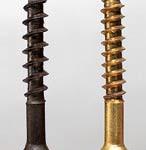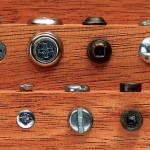What makes a wood screw a wood screw? In general terms, a wood screw has a tapered shape and relatively coarse threads that allow it to hold well in wood. An unthreaded portion directly below the head allows the screw to pull the mating pieces of wood together for a tight joint. That is, the screw passes through the top board and threads into the bottom board. Other types of screws are generally threaded along their entire length, are not as aggressively tapered and may be too fine threaded to securely bite into wood. Wood screws are also specially tempered to withstand a certain degree of stress so they bend without breaking.
Not all wood screws are made the same. In the photo below, the screw on the left has what’s called a “rolled thread” and the one on the right has a “cut thread”. Cut thread is the traditional way of making wood screws. The threaded portion starts out as the same diameter as the unthreaded portion of the shank and gradually tapers towards the tip. However, the thread depth is consistent along the length of the screw to enhance the screw’s holding power in wood. Cut thread screws work best with a tapered drill bit; if a straight bit is used, the end of the screw will have less wood to dig into.
Rolled thread wood screws are made by rolling wire through metal dies under high pressure to form the threads onto the shaft. This results in a screw that is very strong with a thread diameter that is greater than that of the unthreaded shaft (“proud” to the shaft as it were). As you can see in the photo, a rolled thread wood screw has fewer yet coarser and sharper threads than a cut thread screw. Accordingly, it tends to hold better and can be used with a straight bit pilot hole. In many situations, a rolled thread screw can even be installed without drilling a pilot hole thanks to its sharp threads and steep lead angle. If you’re working with plywood, particle board, MDF and the like, it’s hard to beat a rolled thread screw for grip ability.
Rolled thread wood screws are sometimes referred to as “modern” screws. They are gradually gaining a loyal following among woodworkers because of their advantages over the classic tapered wood screw.
Some modern wood screws may be threaded along along their entire length and might be mistaken for coarse-threaded drywall screws. However, a drywall screw is more brittle than a wood screw so the two types of screws are not interchangeable for every application. If the screw is likely to be subjected to sideway stresses, go with the modern wood screw.
Screw Diameters
Screw diameter — the thickness of the shank — is expressed in gauge numbers that range from 0 to 24; the higher the gauge, the thicker the screw. For example, a number 10 gauge (#10) screw is thicker than a number 8 gauge (#8) screw. The most common screw sizes for woodworking applications are #6, #8, #10, and #12. My personal favorite is the #8 screw — it’s strong enough to get the job done but doesn’t require a huge pilot hole. To put these gauge numbers in perspective, a #6 gauge screw is slightly thicker than 1/8 inch whereas a #12 screw is just under 1/4 inch thick.
The available gauge numbers vary for a given screw length. For example, a 1/2″ long screw is available in gauges from 2 to 8, while a 1″ screw is typically available in gauge numbers from 6 to 14. In the U.S., wood screws thicker than 12-gauge are commonly sold by their imperial sizes such as 1/4″, 5/16″, 3/8″ and so on.
Screw Lengths
Wood screws are available in lengths from a 1/4 inch to 6 inches with the 1/2 inch to 3 inch range being most common in hardware stores. The length is measured from the tip of the screw point to the surface of the material into which the screw is driven. In other words, the amount of screw that is actually in the wood. The length of a flat head wood screw is measured from the tip to the top of the head, whereas with a round head screw, the length is measured from the tip to the bottom of the head. In the classic wood screw, the thread extends 2/3rds of the length of the screw. Some newer types of screws are threaded along the entire shank.
Choose the right length screw.
There are no hard and fast rules for screw length requirements but there are some rules of thumb. One of these is that the screw length should be 1/8″ less than the combined thickness of the two boards being joined. This maximizes holding strength while preventing the screw from protruding out the back end of the second board. This rule is appropriate if the two pieces are roughly the same thickness and neither one is exceptionally thick. So, if you’re fastening two 3/4″ boards together, a 1-3/8″ long screw would be an appropriate choice (although 1-1/4″ would also work pretty well and is more commonly available). Another rule of thumb is that 2/3 of the screw should thread into the back piece. For example, if screwing a 1/2″ thick board into a 2″ thick board, a 1-1/2″ long screw would be a good choice because 2/3 of the screw (1″) would be in the bottom piece. As the back piece gets thicker, the ratio can be reduced so only 1/2 of the screw threads into the bottom piece.
Screw Heads
Wood screws are available in a variety of head shapes including flat, round, oval, fillister and square. The flat head screw is the most common. Some might even call it the quintessential wood screw. A flat head screw can be driven flush with the surface or countersunk below the surface and then covered with a wood plug or filler. Probably 99% of the wood screws that I use are of the flat head variety. The other types of screw heads protrude above the work surface although the oval head is something of a hybrid. Half of the head fits into a countersink and the other half projects above the surface. Compared to a round head screw, the oval head does not project as high above the surface and has a classier, more refined look to it. (At least I think so). The flat head screw, which is flat on the bottom and round on the top of the head, is often used to attach a thin object such as a metal plate to wood. They are appropriate for situations where the screw does not need to be concealed. The fillister head has a smaller diameter than the round head but is higher and has a deeper slot. I seldom use fillister head screws but supposedly they work well near flanges and raised surfaces. Square headed screws, aka, lag screws or bolts, are used for heavy duty applications.
Here are top and side views of many of the screw-head styles you’ll encounter. Top row, left to right: flat head, flat head with a separate finishing washer, washer head, and truss head. Bottom row, left to right: round head, oval head, pan head, fillister, and trim head. Photo courtesy of Rockler.com
Wood Screw Tips
A longer screw of smaller diameter will generally provide more holding strength than a shorter but thicker screw. This is because it has more wood to bite into.
Brass screws are relatively soft and subject to snapping off, even with a pilot hole. A simple solution to this problem is to first drive in a steel screw of like size to cut the threads into the wood. Then, remove the steel screw and drive in the brass one.
To make it easier to drive screws into hard woods, first coat the screw threads with bar soap or beeswax. Don’t forget to clean up any residue before applying a finish to the wood.
Bridging or jacking can occur when two boards are being screwed together and the threads pass through the joint line, forcing the two boards apart. To prevent bridging make sure the pilot hole in the top piece is sufficiently wide enough so the screw passes cleanly through the top piece. Securely clamping the two pieces together sometimes works also.
Screws have a greater tendency to work loose when screwed into end grain. To alleviate this possibility, use a longer screw if possible. Another idea, that’s a bit more involved, is to insert a dowel crosswise into the board a short distance from the end of the board and then insert the screw so it bites into the dowel.




